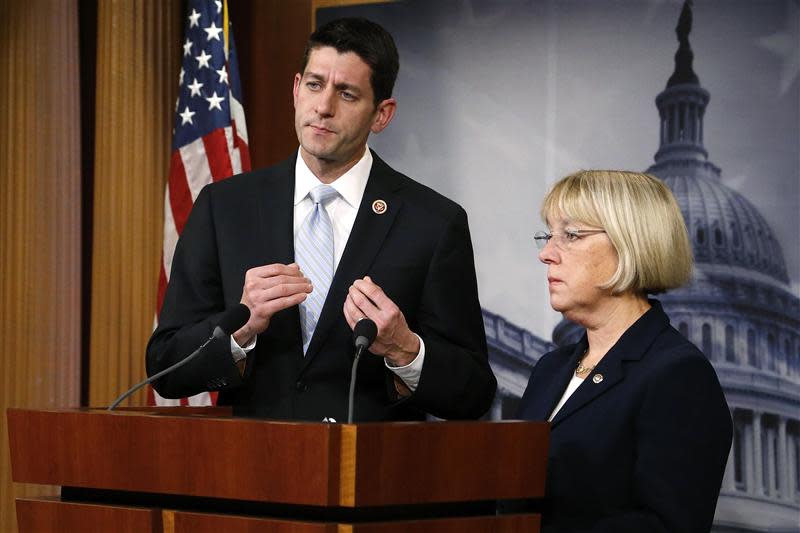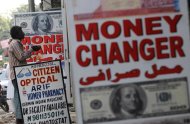U.S. budget deal could usher in new era of cooperation

WASHINGTON
(Reuters) - A bipartisan budget deal announced in the U.S. Congress on
Tuesday, though modest in its spending cuts, would end three years of
impasse and fiscal instability in Washington that culminated in October
with a partial government shutdown.
While praised by the
Republican leadership of the U.S. House of Representatives, including
Speaker John Boehner and Majority Leader Eric Cantor, the agreement
faces a challenge from some House conservatives and will require support
of the minority Democrats to pass.
The backing of President
Barack Obama, who also hailed the agreement as "a good first step,"
should help round up votes of his fellow Democrats. He urged Congress to
quickly pass it.
Obama and most congressional leaders long ago
abandoned talk of larger but increasingly elusive "grand bargains" that
would significantly slash the nation's deficit.
Democratic
Senator Patty Murray and Republican Representative Paul Ryan, who
appeared before reporters Tuesday evening to announce the $85 billion
budget accord, portrayed it as the beginning of a new era.
"For
far too long compromise has been considered a dirty word," said Murray,
chairwoman of the Senate Budget Committee, adding that the uncertainty
created by three solid years of Washington bickering "was devastating to
our economic recovery."
Ryan, the Republican Party's 2012 failed
vice presidential candidate who has his eye on either a 2016
presidential campaign or potentially a House leadership post, wasted no
time in trying to blunt criticism of the pact, especially from fellow
conservatives.
"In divided government, you don't always get what you want," said Ryan, chairman of the House Budget Committee
But
he added, "I think this agreement is a clear improvement on the status
quo. This agreement makes sure that we don't have a government shutdown
scenario in January. It makes sure we don't have another government
shutdown scenario in October. It makes sure that we don't lurch from
crisis to crisis."
Over the last two days, conservative groups,
including Americans for Prosperity and Heritage Action for America,
blasted the deal as it was being negotiated and called on Republicans to
reject it.
Such groups hold sway with some House Republicans,
and with the 2014 congressional elections coming into focus their
opposition could complicate its passage.
The Ryan-Murray plan
would blunt the effect of automatic "sequester" spending cuts by
allowing federal agencies and discretionary programs to spend $63
billion more over two years, while savings are made elsewhere. It also
would provide an additional $20 billion to $23 billion in deficit
reduction over 10 years.
While the measure could improve
Congress' ability to pass must-do bills to keep the government running,
many saw this as marking an end to any chance of Washington enacting a
major new deficit-reduction law anytime soon.
"I've given up on
grand bargain. There's not going to be a big, grand bargain with (this)
Senate and president. That just is not going to happen," said Republican
Representative James Lankford of Oklahoma.
Republican Senator
Marco Rubio, who could compete against Ryan in a 2016 White House bid,
blasted the deal, saying, "This budget continues Washington's
irresponsible budgeting decisions by spending more money than the
government takes in and placing additional financial burdens on everyday
Americans."
SIDESTEPPING TOUGH ISSUES
The accord was
uncharacteristic for a politically polarized Congress that in recent
years has waited until the absolute last moments to reach stop-gap
agreements on the budget and on raising U.S. borrowing limits to avert
historic debt defaults.
Instead, Ryan and Murray came to a
handshake before a non-binding Friday deadline and more than a month
before the January 15 date when existing funds to run many federal
programs expire.
Their work was made easier by the simple fact
that they avoided most of their parties' biggest disagreements in budget
debates: the future of big retirement and healthcare programs that
Republicans want to cut and the closing of tax loopholes that benefit
the rich, which Democrats want to attack.
The House is likely to put the deal to a vote by Friday, before recessing for the year, and a Senate vote might come next week.
Boehner,
who as the House speaker was at the center of bitter budget fights with
Obama in 2011, 2012 and 2013, said: "While modest in scale, this
agreement represents a positive step forward" that, he added, would
further cut budget deficits without tax hikes.
While it included
no tax increases in a strict sense, the Murray-Ryan proposal would cost
consumers some money, as in higher airport security fees that would be
included in airplane ticket purchases.
Among the details of the
bill are $6 billion in cuts to federal workers' retirement benefits and
$6 billion in cuts to military pensions, according to Murray.
These
and other new savings would replace some of the second round of
automatic spending cuts, known as "sequestration," that were scheduled
to begin in January.
Murray and other leading Democrats have been
pushing for an extension of federal jobless benefits that expire later
this month during weeks of budget negotiations.
She told reporters that such a provision is not part of the agreement but is being discussed by congressional leaders.
Also not addressed in this budget deal is the need to again raise U.S. borrowing authority sometime next year.
The
reaction from at least one market-watcher was positive. "It is
certainly a good start to what would be welcomed relief from the fiscal
dysfunction that has defined Washington," said Craig Dismuke, chief
economic strategist at Vining Sparks in Memphis.
Prince Bikram Shah
p.g.d.m - 1st
date 11/12/13












